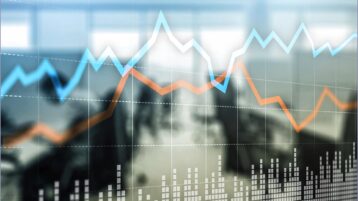The latest U.S. bank earnings show the challenging environment lenders are operating in, as they deal with higher rates and lower investment banking revenue. Greg Bonnell speaks with Stephen Biggar, Director of Financial Institutions Research at Argus Research, about the sector’s outlook.
Print Transcript
[AUDIO LOGO]
With fears of an economic slowdown increasingly in focus, we've been parsing through the latest bank earnings from the big US names this week. Joining us now to take away some of the big takeaways of all this, Stephen Biggar, Director of Financial Institutions Research at Argus Research.
Great to have you back on the program, Stephen.
Good to be here. Thanks for having me, Greg.
All right, so we've heard from some of the biggest names on Wall Street so far. What are the big takeaways from all this?
Well, we had another quarter of big extremes, I would say. The net interest income numbers lines were up 20%, even 30% in many cases-- so just that great tailwind from higher interest rates from the Federal Reserve that we've had all year. You go back last quarter, rates were nearly zero, so any improvement there-- and we've had over 400 basis points of uptick there in rates.
So great on the net interest income line, but the loss provisioning, the other part of the loan business, has been very much an offset. Banks are basically looking forward here and saying, we've got a weaker economy, we've got higher credit card chargeoffs coming, in particular, weaker consumer. The job market is still holding up pretty well, and that's usually a terrific forecaster of delinquencies.
But as you're looking out the next couple of quarters, we do expect-- and chargeoffs have just been so low over the last couple of years, really. So we've had, in many cases, a doubling of loss provisions, and in some cases going from a recapture last year to provisions this year.
And then the other big swing item has been the investment banking side, down 45% and 55% for most of the large banks here. So just a really weak environment for capital raising. Corporate America is taking a break and seeing what the outlook is going to look like here going further into this year, and just seeing some weakness on that side.
So usually, banks are kind of steady state growers, but this time, we just had wild swings in a lot of income lines.
All right. Let's talk a little bit more about the capital markets activities. It's understandable, heading into what you think might be a weaker economy or perhaps even a mild recession, you provision more for losses, you see that slowdown in capital markets activity. If the second half of this year shapes up a little bit better, would there be an appetite? Would there be sort of capital market activity just waiting to hit the market, if we can get past all this?
I think there is, yeah, a fair amount of pent-up demand here. A lot of companies-- I mean, the capital markets and the innovation that's going on in the economy at any given time is-- it's really always there. So there's new companies waiting to come to market. So a fair amount of pent-up demand, I think, particularly in the health care side and almost always in the technology area, as well-- some fintechs that would love to tap the capital markets.
But yeah, we do need, I think, to get beyond the Fed rate increases at this point. James Gorman of Morgan Stanley even mentioned that, saying that he thinks it's off to the races pretty much as soon as the Fed signals the first time they're at zero in terms of rate increases.
So we all are kind of forecasting another couple of 25, maybe a 50 and then a 25, or a few 25 basis point increases here. And then when they get to that zero, or signal that they're done for now, that could be a catalyst for the broader markets and provide some stability, give corporate America that confidence back.
And we talked about investment banking, but M&A activity as well has been soft, not as soft as investment banking. But that's another area where you just want some stability back in the markets. Rates are higher and it's going to cost them more, if you have any financing to do. But a lot of pent-up demand, I think, on the M&A side as well.
So a story that perhaps plays out later this year. In the here and now, we're getting some indications that the US consumer indeed is feeling the bite of these higher borrowing costs. We're seeing retail sales pull back, perhaps a disappointing holiday season. How does that feed through to a bank's credit card business?
Well, yeah. And that definitely bears mentioning. Today's retail sales number down 1%. It shows that the consumer is in a much more cautious mode than they had been in for much of 2022. That was the single worst month decline. It actually matches the November number, which was revised down also to 1%.
So certainly less spending going on by consumers here. And that means less spending on credit cards, and if you think about some of the other big ticket items, clearly mortgages, home buying has moved off, well off its highs. Auto loans as well have been a weak spot.
So I think just, really at this point, a range of all those items. And the retail sales number today was dismal in a lot of categories. It was dining. It was online sales. It was electronics, as well as furniture and housing. So it was really a broad-based move down in retail spending.
So yeah, the credit card companies, they do have a-- I would call it a natural, kind of secular story here, a positive secular story, in that there's still more of a migration from cash and checks to credit cards or to other digital payments. So that's benefiting that long-term growth.
There's a natural tailwind with inflation as well. So if the basket of goods last year at this time cost you $100 and this year it costs you $108 and that's what you're charging on the card, that's obviously a tailwind for those companies. So I don't see a big drop off necessarily, but, yeah, slowing growth rate and in line with the mood of consumers.
We think of so many parts of the banking business, and some of them obviously very high profile and got a lot of ink. But what about deposits? What are we seeing trending in that area coming out of a pandemic? Because that was a pretty interesting space.
Yeah, deposits-- throughout the pandemic, banks were just flush with deposits. Consumers were saving a lot. They got government stimulus checks in the US, Canada as well. They reined in spending because, well, you couldn't fly. A lot of things were closed. You couldn't travel. You could shift your spending online, to some extent. But there just wasn't that spending that went on.
So deposit accounts, checking accounts really moved much, much higher during the pandemic. So banks flush with cash. Rates were at zero, so you couldn't get a good yielding CD. Bond yields were much lower as well. So a lot of people just hoarded cash until very recently, in just the second half of '22, where the Fed moves higher have allowed some really decent yields across the spectrum. High grade bonds, municipal securities, CDs, even savings accounts are yielding much higher.
So there's a migration that's taking place. Whereas banks, the net interest margin expansion was really spectacular for much of 2022, as banks raised the rates on loans and didn't really raise the rates as quickly on the deposits and the other funding sources. But that's changed now. So you've got most of the benefit has been achieved on the raising of the lending rates.
But now you're finding that consumers are getting smarter, seeing these much higher yields that are available in the market through CDs and other bonds and other securities and transferring these non-interest-bearing deposits to something that carries a pretty decent yield. So that, on the back end, will, we think, start to hurt, actually, net interest margins as we move through 2023. [AUDIO LOGO]
[MUSIC PLAYING]
With fears of an economic slowdown increasingly in focus, we've been parsing through the latest bank earnings from the big US names this week. Joining us now to take away some of the big takeaways of all this, Stephen Biggar, Director of Financial Institutions Research at Argus Research.
Great to have you back on the program, Stephen.
Good to be here. Thanks for having me, Greg.
All right, so we've heard from some of the biggest names on Wall Street so far. What are the big takeaways from all this?
Well, we had another quarter of big extremes, I would say. The net interest income numbers lines were up 20%, even 30% in many cases-- so just that great tailwind from higher interest rates from the Federal Reserve that we've had all year. You go back last quarter, rates were nearly zero, so any improvement there-- and we've had over 400 basis points of uptick there in rates.
So great on the net interest income line, but the loss provisioning, the other part of the loan business, has been very much an offset. Banks are basically looking forward here and saying, we've got a weaker economy, we've got higher credit card chargeoffs coming, in particular, weaker consumer. The job market is still holding up pretty well, and that's usually a terrific forecaster of delinquencies.
But as you're looking out the next couple of quarters, we do expect-- and chargeoffs have just been so low over the last couple of years, really. So we've had, in many cases, a doubling of loss provisions, and in some cases going from a recapture last year to provisions this year.
And then the other big swing item has been the investment banking side, down 45% and 55% for most of the large banks here. So just a really weak environment for capital raising. Corporate America is taking a break and seeing what the outlook is going to look like here going further into this year, and just seeing some weakness on that side.
So usually, banks are kind of steady state growers, but this time, we just had wild swings in a lot of income lines.
All right. Let's talk a little bit more about the capital markets activities. It's understandable, heading into what you think might be a weaker economy or perhaps even a mild recession, you provision more for losses, you see that slowdown in capital markets activity. If the second half of this year shapes up a little bit better, would there be an appetite? Would there be sort of capital market activity just waiting to hit the market, if we can get past all this?
I think there is, yeah, a fair amount of pent-up demand here. A lot of companies-- I mean, the capital markets and the innovation that's going on in the economy at any given time is-- it's really always there. So there's new companies waiting to come to market. So a fair amount of pent-up demand, I think, particularly in the health care side and almost always in the technology area, as well-- some fintechs that would love to tap the capital markets.
But yeah, we do need, I think, to get beyond the Fed rate increases at this point. James Gorman of Morgan Stanley even mentioned that, saying that he thinks it's off to the races pretty much as soon as the Fed signals the first time they're at zero in terms of rate increases.
So we all are kind of forecasting another couple of 25, maybe a 50 and then a 25, or a few 25 basis point increases here. And then when they get to that zero, or signal that they're done for now, that could be a catalyst for the broader markets and provide some stability, give corporate America that confidence back.
And we talked about investment banking, but M&A activity as well has been soft, not as soft as investment banking. But that's another area where you just want some stability back in the markets. Rates are higher and it's going to cost them more, if you have any financing to do. But a lot of pent-up demand, I think, on the M&A side as well.
So a story that perhaps plays out later this year. In the here and now, we're getting some indications that the US consumer indeed is feeling the bite of these higher borrowing costs. We're seeing retail sales pull back, perhaps a disappointing holiday season. How does that feed through to a bank's credit card business?
Well, yeah. And that definitely bears mentioning. Today's retail sales number down 1%. It shows that the consumer is in a much more cautious mode than they had been in for much of 2022. That was the single worst month decline. It actually matches the November number, which was revised down also to 1%.
So certainly less spending going on by consumers here. And that means less spending on credit cards, and if you think about some of the other big ticket items, clearly mortgages, home buying has moved off, well off its highs. Auto loans as well have been a weak spot.
So I think just, really at this point, a range of all those items. And the retail sales number today was dismal in a lot of categories. It was dining. It was online sales. It was electronics, as well as furniture and housing. So it was really a broad-based move down in retail spending.
So yeah, the credit card companies, they do have a-- I would call it a natural, kind of secular story here, a positive secular story, in that there's still more of a migration from cash and checks to credit cards or to other digital payments. So that's benefiting that long-term growth.
There's a natural tailwind with inflation as well. So if the basket of goods last year at this time cost you $100 and this year it costs you $108 and that's what you're charging on the card, that's obviously a tailwind for those companies. So I don't see a big drop off necessarily, but, yeah, slowing growth rate and in line with the mood of consumers.
We think of so many parts of the banking business, and some of them obviously very high profile and got a lot of ink. But what about deposits? What are we seeing trending in that area coming out of a pandemic? Because that was a pretty interesting space.
Yeah, deposits-- throughout the pandemic, banks were just flush with deposits. Consumers were saving a lot. They got government stimulus checks in the US, Canada as well. They reined in spending because, well, you couldn't fly. A lot of things were closed. You couldn't travel. You could shift your spending online, to some extent. But there just wasn't that spending that went on.
So deposit accounts, checking accounts really moved much, much higher during the pandemic. So banks flush with cash. Rates were at zero, so you couldn't get a good yielding CD. Bond yields were much lower as well. So a lot of people just hoarded cash until very recently, in just the second half of '22, where the Fed moves higher have allowed some really decent yields across the spectrum. High grade bonds, municipal securities, CDs, even savings accounts are yielding much higher.
So there's a migration that's taking place. Whereas banks, the net interest margin expansion was really spectacular for much of 2022, as banks raised the rates on loans and didn't really raise the rates as quickly on the deposits and the other funding sources. But that's changed now. So you've got most of the benefit has been achieved on the raising of the lending rates.
But now you're finding that consumers are getting smarter, seeing these much higher yields that are available in the market through CDs and other bonds and other securities and transferring these non-interest-bearing deposits to something that carries a pretty decent yield. So that, on the back end, will, we think, start to hurt, actually, net interest margins as we move through 2023. [AUDIO LOGO]
[MUSIC PLAYING]



























